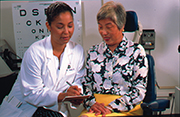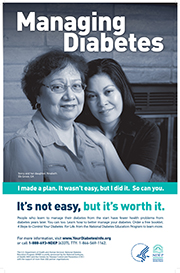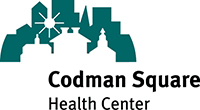Educational Resource Spotlight: Glaucoma Eye-Q Test
Healthy Vision Community Programs Database

This easy-to-search resource can help you learn about new ways to address eye health issues and replicate eye health-related projects in your community. Visit the Healthy Vision Community Programs Database at /nehep//.
The National Eye Health Education Program is coordinated by the National Eye Institute, National Institutes of Health, U.S. Department of Health and Human Services. This administrative document may be reprinted without permission.
In This Issue:
-
Minority Primary Care Physicians' Knowledge, Attitudes and Practices on Eye Health
-
Helen Keller International Wins Award for Preventing Blindness
-
Lighthouse International Launches East Harlem—Early Action Saves Sight Pilot Program
-
Prevent Blindness America Releases Report Detailing Activities of Key Public Health Collaboration
-
Optometrists Are Working With Patients to Reduce Diabetic Retinopathy
-
The National Diabetes Education Program Provides Free Materials to Help People Manage Diabetes
-
Integration: Working Together Toward Better Vision and Eye Health

Letter From the Chair of the NEHEP Planning Committee
As eye health professionals, we are able to help prevent vision loss and blindness as part of our daily lives. As a resolution for the new year, I would like to see the eye health community translate greater public awareness about health concerns and health care into increased outreach that will impact the public's health.
Through the past year's wide-ranging discussions of health insurance legislation, public attention has been primed on the topic of health care, creating opportunities to advance a disease-prevention agenda. Accompanying these debates, there has been heightened public scrutiny of various healthcare practices with an emphasis on garnering the greatest possible health benefit from healthcare expenditures. The confusion and outcry associated with the recent recommendations by the U.S. Preventive Services Task Force on breast cancer screening underscore the challenges of communicating effectively when the health stakes are high.
January is Glaucoma Awareness Month. This provides a great opportunity to enhance our education efforts this year about the importance of early detection and timely treatment of glaucoma. Research shows that African Americans over age 40, people over age 60 (especially Mexican Americans), and those with a family history of the disease are at elevated risk of developing glaucoma. Eye health professionals can provide health benefits by conducting comprehensive dilated eye exams for those at risk, and taking straightforward steps such as mentioning to glaucoma patients that their relatives have an elevated risk of the disease. Such a message may encourage family members to seek care that could reveal a previously undetected (and untreated) disease. The National Eye Health Education Program (NEHEP) has developed a variety of free resources, and we encourage you to use them to reach out to those at higher risk for glaucoma. To find educational resources with suggestions for glaucoma outreach, visit http://www.nei.nih.gov/nehep/programs/glaucoma.
Primary care physicians are a critical source of health information for patients, and they can play a significant role in preventing vision loss and blindness. The article, "Minority Primary Care Physicians' Knowledge, Attitudes, and Practices on Eye Health," in this issue of Outlook, highlights findings from a web-based survey of primary care physicians about their perceptions and attitudes concerning communication about eye health with patients. Racial and ethnic similarities between patients and physicians appear to be a factor in patient-physician communication, but it goes without saying that effective patient-physician communication involves much more than ethnic heritage and that the provision of quality health care is a great way to transcend differences in background. Of overarching importance is the conclusion that effective patient-physician communication about eye health, especially among those at higher risk for eye disease, can play a key role in preventing vision loss.
This issue of Outlook also includes a variety of stories submitted by some of our NEHEP Partnership organizations that highlight their eye health education activities around the country. I would especially like to extend my congratulations to EyeCare America, a public service program of the Foundation of the American Academy of Ophthalmology, which is celebrating its 25th anniversary. All of our NEHEP Partnership organizations do great work in raising awareness of eye health, and we continue to salute your involvement in preventing vision loss by working to make eye health a priority. I send my best wishes to all of you for a happy, healthy, productive new year. I look forward to continuing to work together in 2010 to expand our reach and our public health impact in support of vision health.
Anne Louise Coleman, M.D., Ph.D.
Chair, National Eye Health Education Program Planning Committee
Frances and Ray Stark Professor of Ophthalmology
Jules Stein Eye Institute
David Geffen School of Medicine at UCLA
and
Professor of Epidemiology
UCLA School of Public Health
Minority Primary Care Physicians' Knowledge, Attitudes, and Practices on Eye Health
Minorities in the United States are at higher risk of developing eye diseases, such as diabetic retinopathy, glaucoma, and cataract.1-3 These diseases can lead to loss of productivity and reduced quality of life, and their growing prevalence in minority populations is a major public health problem. 1-3
Physicians are a critical source for health information for patients and as such, they can play a significant role in preventing vision loss and blindness. Minority physicians are more likely than other physicians to see minority patients. Racial and ethnic similarities between patients and physicians are important factors in improving patient-physician communication.4
To gain a better understanding of physicians, in 2007, the National Eye Institute (NEI) included key eye health knowledge, attitudes, and practices questions in the DocStyles survey, a web-based survey of primary care physicians about physician perceptions and attitudes concerning communication with patients. Of those that completed the survey, 428 physicians (or 28.5% of the total sample group) reported that they were Hispanic or part of a minority group. Here are some of the key findings:
physicians about physician perceptions and attitudes concerning communication with patients. Of those that completed the survey, 428 physicians (or 28.5% of the total sample group) reported that they were Hispanic or part of a minority group. Here are some of the key findings:
- Seventy-eight percent (78%) of minority physicians reported knowing that many eye diseases (such as diabetic eye disease, glaucoma, and age-related macular degeneration) do not have early warning signs or symptoms.
- Sixty percent (60%) reported that they could identify patients at higher risk for eye disease.
- Just over half (52%) believed they had adequate knowledge to advise their patients on eye health.
- Sixty-two percent (62%) felt that talking with patients about vision and eye health was their responsibility and not just the responsibility of the optometrist or ophthalmologist.
- Sixty-four percent (64%) reported that encouraging patients to get a dilated eye exam was their responsibility.
- Only 61 percent, however, reported talking with patients about their vision and eye health even when patients do not bring it up themselves.
Seventy-five percent (75%) of minority physicians reported that they were more likely to recommend that their patients see an eye care professional for an eye exam whether or not they had any vision problems. Interestingly, 25 percent of the physicians in this group reported that in the past 12 months they referred fewer than 10 percent of their patients, or none at all, for a dilated eye exam.
Results from the 2007 DocStyles survey demonstrated favorable attitudes and opinions by minority physicians regarding eye health and the role they should play in talking with patients about it. Survey findings also reveal, however, both a need and an opportunity to increase physician confidence in identifying patients at higher risk for eye disease and advising their patients on eye health.
To learn more about the 2007 DocStyles survey findings addressed here, you can read the full text article, “Minority Primary Care Physicians’ Knowledge, Attitudes, and Practices on Eye Health and Preferred Sources of Information” in the Journal of the National Medical Association, December 2009.
References
1 Higginbotham, E. J., Gordon, M. O., Beiser, J. A., et al. (2004). The Ocular Hypertension Treatment Study: Topical medication delays or prevents primary open-angle glaucoma in African-American individuals. Archives of Ophthalmology, 122: 813–820.
2 Kempen, J. H., O’Colmain, B. J., Leske, M. C., et al. (2004). The prevalence of diabetic retinopathy among adults in the United States. Archives of Ophthalmology, 122: 552–563.
3 Varma, R., Ying-Lai, M., Klein, R., et al. (2004). Prevalence and risk indicators of visual impairment and blindness in Latinos. The Los Angeles Latino Eye Study.
Ophthalmology, 111: 1132–1140.
4 Brown, T. T., Scheffler, R. M., Tom, S. E., et al. (2007). Does the market value racial and ethnic concordance in physician-patient relationships? Health Services Research, 42(2): 706–726.
Help Educate Your Community About Glaucoma
January is Glaucoma Awareness Month. This is a great time to raise awareness in your community about this disease, which has no warning signs.
 |
 |
| Normal Vision | Vision with Glaucoma |
Although treatments to slow the progression of the disease are available, at least half of those who have glaucoma are not receiving treatment because they are unaware of their condition.1 Fortunately, a comprehensive dilated eye exam can detect glaucoma, and early detection may minimize vision loss. People at higher risk for glaucoma include African Americans over age 40, people over age 60, especially Mexican Americans, and those with a family history of the disease.
The National Eye Institute (NEI) offers a wide variety of resources that you can use to help educate the public about glaucoma and the importance of having a dilated eye exam to detect it. For example, try using the Eye-Q test, a 10-question true-false quiz that can help people at higher risk for glaucoma learn more about the disease and protect their vision. You will find an assortment of materials at http://www.nei.nih.gov/glaucomaeducation//.
For ideas about how to get the word out, be sure to look at Educating Your Community about Glaucoma. This resource is part of the Healthy Vision Toolkit and it contains facts about glaucoma, activity suggestions, promotional materials, and a brochure.
Visit the National Eye Health Education Program Glaucoma Webpage for additional suggestions about community activity outreach opportunities.
Reference
1 National Eye Institute & Lions Clubs International Foundation. (2007). 2005 survey of public knowledge, attitudes, and practices related to eye health and disease. Bethesda, MD: National Eye Institute. Available at: http://www.nei.nih.gov/kap/.
Helen Keller International Wins Award for Preventing Blindness
Helen Keller International (HKI) received the prestigious António  Champalimaud Vision Award from the Lisbon-based Champalimaud Foundation in September 2009. HKI was recognized for its achievements in preventing blindness in the developing world, particularly efforts to find effective and sustainable means to combat vitamin A deficiency (VAD).
Champalimaud Vision Award from the Lisbon-based Champalimaud Foundation in September 2009. HKI was recognized for its achievements in preventing blindness in the developing world, particularly efforts to find effective and sustainable means to combat vitamin A deficiency (VAD).
VAD is the number one cause of preventable childhood blindness, and significantly increases the risk of severe illness, and even death, from such common childhood infections as diarrhea and measles. The World Health Organization (WHO) estimates that as many as 140 million children, especially in Africa and Southeast Asia, suffer from VAD. Each year up to 500,000 children go blind from the condition, and 70 percent of them will die within 1 year of losing their sight.
While the problem of VAD is widespread, there are proven, cost-effective solutions available. Just two high-potency vitamin A capsules are needed per child, per year, to control VAD; the cost of delivering these capsules twice a year is just $1.00 per child, per year. HKI currently offers vitamin A supplementation in 13 African countries and 5 in the Asia-Pacific region. HKI partners with governments, other international organizations, and local groups to create sustainable delivery systems to reach more than 80 percent of targeted children. Last year, 41 million African children and 46 million Asian children benefitted from HKI’s programs.
VAD can also be prevented by eating foods rich in vitamin A or by fortifying commonly used foods, such as cooking oil, with vitamin A. HKI has established community-based programs that teach local villagers how to grow fruits and vegetables high in vitamin A and other micronutrients, and HKI has also become involved in the development and promotion of an orange-fleshed variety of sweet potato in Africa that is rich in vitamin A. In West Africa, HKI’s public-private partnership, Tache D’Huile, focuses on fortifying cooking oil with vitamin A with the aim of reaching 70 percent of the population by the end of 2010.
The Champalimaud Foundation, one of the largest global science foundations in the world, initiated the €1 million (U.S. $1.4 million) Champalimaud Award in 2006. Since then, it has alternately been given for blindness prevention on the ground and in scientific research. The award has the support of WHO’s VISION 2020 initiative, and has been referred to as the “Nobel Prize for Vision” by the former president of India, A. P. J. Kalam.
For more information on HKI’s vitamin A supplementation programs or the 2009 Champalimaud Award, contact Jennifer Klopp, Vice President of Development and Communications, at jklopp@hki.org.EyeCare America Celebrates 25 Years of Saving Sight
![]()
This award-winning program has been recognized by every sitting U.S. president since Ronald Reagan and has received the support of many celebrities including Bob Hope, Gene Kelly, Bill Cosby, Senator John Glenn, Oscar de La Hoya, and TV legend Betty White.
In honor of its 25th anniversary, EyeCare America would like to encourage people to call 1–800–222–EYES (3937) to find out if they qualify for an eye exam at no cost. EyeCare America is a year-round program. Its helpline operates 24 hours a day, year-round.
The program facilitates eye care for U.S. citizens or legal residents who are without an ophthalmologist and who do not belong to an HMO or do not have eye care coverage through the Veterans Administration. To be found eligible for the program an individual should fall into one of the two categories below:
- Those aged 65 or older who have not seen an ophthalmologist in 3 or more years may be eligible to receive a comprehensive, medical eye exam and up to 1 year of care at no out-of-pocket cost for any disease diagnosed during the initial exam. Volunteer ophthalmologists will waive copayments, accepting Medicare and/or other insurance reimbursement as payment in full. Patients without insurance receive this care at no charge.
- Those who are at increased risk for glaucoma (determined by age, race, and family history) and have not had an eye exam in 12 months or more may be eligible to receive a free glaucoma eye exam if they are uninsured. Those with insurance will be billed for the exam and are responsible for any copayments. The initiation of treatment is provided, if deemed necessary by the doctor during the exam.
More information can be found at: www.eyecareamerica.org.
Lighthouse International Launches East Harlem-Early Action Saves Sight Pilot Program
Lighthouse International has launched the  East Harlem–Early Action
Saves Sight (EH–EASS) pilot program, a 2-year effort to raise awareness among older adults about the importance of quick action when there is a change in vision.
East Harlem–Early Action
Saves Sight (EH–EASS) pilot program, a 2-year effort to raise awareness among older adults about the importance of quick action when there is a change in vision.
Comprised mostly of Hispanic/Latino and African-American residents, East Harlem, NY, is an underserved community where the prevalence of diabetes is the highest in New York City and among the highest in the Nation. Up to 40 percent of all individuals with diabetes will eventually develop diabetic retinopathy, which will lead to blindness if left untreated. Many residents are low-income elderly people who may not have access to quality health and vision care. Cultural beliefs and practices, fear of the healthcare system, and transportation concerns may pose additional obstacles to health and vision care.
EH–EASS is designed to reduce disparities in access to care for this highly vulnerable population through vision education and services provided in the community. EH–EASS underscores the importance of seeing an optometrist or ophthalmologist as quickly as possible—should a vision problem arise—to speed diagnosis, treatment, and minimize the chances of vision being irrevocably lost. A key element is follow-up with those at highest risk to encourage them to get eye exams.
EH–EASS introduces critical new players to the vision outreach team—patient navigators—who will identify and remove the numerous cultural, social, and economic barriers to vision care within the community. The patient navigator model has been successful in eliminating obstacles to screenings and treatment for people at high risk for cancer. The EH–EASS program may represent the first time a community-based patient navigator model will be used by a vision-focused agency. With help from researchers in the Lighthouse Evaluation Unit, Lighthouse will be able to study the effectiveness of patient navigators in improving access to eye care and, ultimately, share the results with other vision care organizations so they can replicate this innovative model in other high-risk communities.
The EH–EASS team is comprised of numerous local, city, and state organizations and agencies committed to addressing all aspects of the diabetes crisis facing East Harlem residents. Together, Lighthouse International, community partners, and funders hope to have a dramatic and positive impact on the health and well-being of some of the most underserved New Yorkers.
This program is made possible thanks to the generosity of The Harry and Jeanette Weinberg Foundation, Genentech, and Communities IMPACT Diabetes Center.
Prevent Blindness America Releases Report Detailing Activities of Key Public Health Collaboration

In 2005, CDC, under its Vision Health Initiative, entered a collaborative partnership with Prevent Blindness America to address vision loss and related eye diseases.
With the CDC grant, Prevent Blindness America was able to undertake key vision preservation and vision-loss initiatives, including:
- State-based programs aimed at detecting and treating vision problems.
- Efforts to ensure appropriate follow-up care to vision screening programs.
- Development of a national data collection system.
- Establishment of crucial ongoing partnerships with public health organizations such as the National Association of Chronic Disease Directors.
- Public education through state-based vision symposiums.
- Implementing strategies to integrate vision and eye health into state public systems.
- Expansion of programs to new territories throughout the country.
In 2008, CDC entered into a new agreement with Prevent Blindness America to fund the nonprofit organization’s “National Vision Preservation Initiative,” an effort to develop an integrative approach to eye health promotion and vision loss prevention.
The new 3-year cooperative agreement, which includes an approximate $3 million grant to Prevent Blindness America, involves several participating organizations: Duke Clinical Research Institute, Johns Hopkins Bloomberg School of Public Health, New York State Department of Health, Prevent Blindness North Carolina, Prevent Blindness Ohio, and Prevent Blindness Tri-State.
The National Vision Preservation Initiative is currently funding evaluations of adult vision health programs at community health clinics in Ohio, as well as a pediatric-focused effort in North Carolina. Additionally, a statewide vision integration program is underway in partnership with the New York State Health Department and a new comprehensive national database for clinical and public health data related to vision and eye health is under development.
“It is imperative that we have partnerships with institutions like the Centers for Disease Control and Prevention in order to address the ever-growing needs of our country’s population. This partnership allows our organization to continue to carry out our mission to promote vision and eye health, and safety,” said Hugh R. Parry, president and CEO of Prevent Blindness America.
The full report can be found at www.preventblindness.net/CDC_summary. For more information, contact Sarah Hecker at Prevent Blindness America at 312–363–6035 or shecker@preventblindness.org.Optometrists Are Working With Patients To Reduce Diabetic Retinopathy
In 2001, the American Optometric Association Board  approved the formation of the Healthy Eyes Healthy People® program (HEHP).1 HEHP® is a program developed to encourage community projects in health promotion and disease prevention that carries out the vision objectives of Healthy People 2010, an initiative to promote the prevention of certain diseases that are devastating the American public today. The HEHP® award is up to $5,000 in grant money and is meant to further the initiatives of individuals trying to develop new projects, such as diabetes education and prevention methods. From 2004-2009, there were a total of 279 grants of $1 million awarded from the HEHP® program, of which 80 awards were aimed at reducing the visual impairment due to diabetic retinopathy.
approved the formation of the Healthy Eyes Healthy People® program (HEHP).1 HEHP® is a program developed to encourage community projects in health promotion and disease prevention that carries out the vision objectives of Healthy People 2010, an initiative to promote the prevention of certain diseases that are devastating the American public today. The HEHP® award is up to $5,000 in grant money and is meant to further the initiatives of individuals trying to develop new projects, such as diabetes education and prevention methods. From 2004-2009, there were a total of 279 grants of $1 million awarded from the HEHP® program, of which 80 awards were aimed at reducing the visual impairment due to diabetic retinopathy.
Optometrists, along with healthcare professionals, can find ways to help diabetes patients who are at risk for diabetic retinopathy.2 Results from one intervention suggest that a complete diabetes management education along with diabetes consultants, such as primary care providers, diabetes educators, and endocrinologists are essential to control the complications related to diabetes.2 Through timely detection and treatment, vision loss can be prevented.2 The HEHP® program emphasizes an annual comprehensive dilated eye exam as well as patient education to reduce the cases of diabetic retinopathy. Patient education is a better way of intervention as compared to usual eye care.2 A complete eye examination in addition to education on diabetes are both helpful tools to control diabetic retinopathy.
According to research, awareness of the eye complications of diabetes is low among the Hispanic population in the United States.3 Among the Hispanic individuals with diabetes the frequency of eye examinations is less than the national average.3 There is a need for culturally suitable health education, which may reduce barriers to eye care.3 The HEHP® program is working with the Hispanic population in a number of States to reduce this disparity through providing brochures and other educational material in Spanish. Optometrists are playing a significant role in all 50 states by detecting, treating, and educating their patients about the problems related to diabetic retinopathy through the HEHP® program. The HEHP® grants are a resource for optometrists to use in creating community health programs that recognize the importance of vision services particularly related to diabetic retinopathy.
For more information about the Healthy Eyes Healthy People® program, contact Uzma A. Zumbrink, M.P.H., Associate Director of Public Health, American Optometric Association, at 314-983-4146 or uazumbrink@aoa.org.
References
1
American Optometric Association. (2009). Diabetic Retinopathy. Retrieved from http://aoa.org/diabetic-retinopathy.xml.
2 Wagner, H., Pizzimenti, J. J., Daniel, K., Pandya, N., & Hardigan, P. C. (2008). Eyes on diabetes: A multidisciplinary patient education intervention. The Diabetes Educator, 34 (1), 84-89.
3 Munoz, B., O'Leary, M., Fonseca-Becker, F., Rosario, E., Burguess, I., Aguilar, M., Fickes, C., et al. (2008). Knowledge of diabetic eye disease and vision care guidelines among Hispanic individuals in Baltimore with and without diabetes. Archives of Ophthalmology,126(7), 968-974.
The National Diabetes Education Program Provides Free Materials To Help People Manage Diabetes

The key is making a plan. People who learn to manage their diabetes from the start have fewer health problems from diabetes in the years that follow.
Translating research into action, the National Diabetes Education Program (NDEP), a joint program of the National Institutes of Health and the Centers for Disease Control and Prevention, has revised its Control Your Diabetes. For Life. campaign. The messages in this campaign recognize that managing diabetes is not easy, but provide much-needed reinforcement about the benefits of managing diabetes, and offer action steps to help patients make a plan.
Campaign materials (which are free and available in English and Spanish) include a variety of tools, such as posters, fact sheets, feature articles, and e-newsletter blurbs that can be downloaded and customized to help communicate this important message as part of eye health education programs across the country.
Additionally, you can use NDEP patient education resources (also available in English and Spanish) to complement important eye health messages, such as:
- 4 Steps to Control Your Diabetes. For Life—an easy-to-read booklet that helps people with diabetes understand vital self-care principles, including having a dilated eye exam once a year to check for eye problems.
- If You Have Diabetes, Know Your Blood Sugar Numbers—a tip sheet that contains information on the A1C test, self-monitoring blood glucose, and working with a healthcare team to set blood glucose targets and reach them.
To order a free copy of NDEP’s 4 Steps to Control Your Diabetes. For Life. booklet or If You Have Diabetes, Know Your Blood Sugar Numbers tip sheet, please visit www.YourDiabetesInfo.org or call 1–888–693–NDEP (6337); TTY: 1–866–569–1162. Materials are available on printer-ready CDs, making it convenient for organizations to add their logo and print desired quantities.
For more information, contact Rachel Byrd at 202–842–3600 or rbyrd@hagersharp.com.Integration: Working Together Toward Better Vision and Eye Health
The Vision and Eye Health Council of the![]() National Association of Chronic Disease Directors (NACDD) is working to encourage program integration to better use existing vision-related resources, reduce gaps in vision-related services, and enhance vision preservation, eye health and surveillance strategies. The mission of the Council is to provide leadership and expertise for the development of and/or assistance to state-based vision programs by promoting links between eye health and chronic diseases and fostering integration of vision-related activities and messages within chronic disease programs.
National Association of Chronic Disease Directors (NACDD) is working to encourage program integration to better use existing vision-related resources, reduce gaps in vision-related services, and enhance vision preservation, eye health and surveillance strategies. The mission of the Council is to provide leadership and expertise for the development of and/or assistance to state-based vision programs by promoting links between eye health and chronic diseases and fostering integration of vision-related activities and messages within chronic disease programs.
Integration of vision and eye health information into existing programs can increase the effectiveness, efficiency, and impact of involved programs and stakeholders without compromising the individual integrity of either entity. Public health programs and organizations across the nation are uniquely positioned to deliver vision and eye health messages and information to their populations through existing chronic disease initiatives. By integrating information, program action plans can be enriched, resources can be used more efficiently, collaborations can be enhanced, health messages can be standardized, and gaps in services and activities can be reduced.
Vision and eye health information can easily be integrated into many current chronic disease initiatives. The risk of vision impairment cuts across age groups, races, ethnicities, genders, health status, and lifestyles. Mounting evidence indicates an association between vision loss and some modifiable risk factors such as smoking,1-4 ultraviolet light exposure,1, 2 trauma,5 poor nutrition,4 blood sugar,1, 2 lipid2 and blood pressure control,1 obesity,4 and lack of physical activity.6 Major chronic diseases, such as heart disease and stroke,1, 7, 8 hypertension,1, 2 diabetes,1, 2 arthritis,9 cancer,10-12 HIV/AIDS,13-15 and kidney disease,16 can be associated with vision impairment and blindness.
Integrating vision messages into existing programs or activities need not be time consuming or difficult. Efforts should enhance existing action plans, not create new ones. The NACDD Vision Council would like to invite you to join their efforts to promote vision and eye health integration activities. If your organization is interested in program integration, contact Kim Kronenberg, NACDD Vision and Health Council Consultant, at kimkronenberg@verizon.net or visit www.chronicdisease.org and click on Vision and Eye Health.
References
1Age-Related Eye Disease Study Results. (2008). Retrieved November 11, 2009, from National Eye Institute Website: http://www.nei.nih.gov/amd/background.asp.
2 Pelletier, Thomas, Shaw. (2009). Vision loss in older persons. American Family Physician, 79(11), 963–70.
3 Khan, Thurlby, Shahid, Clayton, Yates, Bradley, Moore, Bird. (2006). Smoking and age related macular degeneration: the number of pack years of cigarette smoking is a major determinant of risk for both geographic atrophy and choroidal neovascularisation. British Journal of Ophthalmology, 90, 75–80.
4 Schaumberg, Nichols, Kelly. (2006). The Global Sex Disparity in Blindness and Visual Impairment. Optometry and Vision Science, 83(10), 700–701.
5 Kuhn, Morris, Witherspoon, Mann. (2006). Epidemiology of Blinding Trauma in the United States Eye Injury Registry. Ophthalmic Epidemiology, 13(3),209–216.
6 Knudtson, Klein, Klein. (2006). Physical activity and the 15-year cumulative incidence of age-related macular degeneration: the Beaver Dam Eye Study. British Journal of Ophthalmology, 90, 1461–1463.
7 Tedeschi-Reiner, Strozzi, Skoric, Reiner. (2005). Relation of Atherosclerotic Changes in Retinal Arteries to the Extent of Coronary Artery Disease. The American Journal of Cardiology, 96, 1107–1109.
8 Witt et al., (2006). Abnormalities of Retinal Microvascular Structure and Risk of Mortality From Ischemic Heart Disease and Stroke. Hypertension, 47, 975–981.
9 Thorne, Woreta, Kedhar, Dunn, Jabs. (2007). Juvenile idiopathic arthritis-associated uveitis: incidence of ocular complications and visual acuity loss. American Journal of Ophthalmology, 143(5), 840–846.
10 Researchers Detail Chemotherapy’s Damage to the Brain. (2008). Retrieved November 11, 2009, from URMC Newsroom Website: http://www.urmc.rochester.edu/news/story/index.cfm?id=1963.
11 Detailed Guide: Eye Cancer. (2009). Retrieved November 11, 2009, from American Cancer Society Website: http://www.cancer.org/docroot/cri/content/cri_2_4_1x_What_is_Eye_Cancer_74.asp.
12 Childhood Cancer: Late effects of cancer treatment. (2009). Retrieved November 11, 2009, from American Cancer Society Website:
http://www.cancer.org/docroot/cri/content/cri_2_6x_late_effects_of_childhood_cancer.asp.
13 Kestelyn, Philippe G. and Cunningham JR, Emmett T. HIV/AIDS and blindness. Bull World Health Organ [online]. 2001, vol.79, n.3 [cited 2009-11-23], pp. 208-213. Available from: http://www.scielosp.org/scielo.php?script=sci_arttext&pid=S0042-96862001000300008&lng=en&nrm=iso.
14 Holland. (2008). AIDS and Ophthalmology: The First Quarter Century. American Journal of Ophthalmology, 145(3), 397-408.
15 Ahmed, I., Everett, A., Chang, E., Luckie, A. (2006, January). Ophthalmic Manifestations of HIV. Retrieved November 11, 2009, from UCSF HIV InSite Website: http://hivinsite.ucsf.edu/InSite?page=kb-04-01-12.
16 Sabanayagam et al. (2009). Retinal Microvascular Caliber and Chronic Kidney Disease in an Asian Population. American Journal of Epidemiology, 169(5), 625-632.
17 Liew, Mitchell, Wong, Iyengar, Wang. (2008). CKD increases the risk of age-related macular degeneration. Journal of the American Society of Nephrology, 19(4), 806-11.
Healthy Vision Community Awards Spotlight: Codman Square Health Center

The current approach to the diagnosis and treatment of glaucoma at the clinic is consistent with American views on health and illness, but the Haitian point of view differs significantly. It is reported in the literature that Haitian people do not perceive that they are ill unless the illness interferes with their ability to work.2 Treatment compliance depends on the perceived severity of the illness. Noncompliance is attributed to difficulty understanding the nature of chronic diseases, difficulty accessing and maintaining a relationship with a healthcare provider, and reliance on traditional/magical treatments.3, 4
The usual cultural, educational, and language differences of the Haitian population— combined with a common lack of early warning symptoms for glaucoma—make its diagnosis and treatment particularly challenging with this group. Despite the comprehensive approach taken at the eye clinic to address glaucoma, these patients often discontinue using prescribed medications, miss appointments, or expect a cure from one bottle of glaucoma medication.
The Patient Education About Glaucoma Through the Eyes of the Haitian Patient project focuses on gaining insight and understanding on the perspectives of the Haitian community on glaucoma. The objectives of the project are to:
- Initiate effective and culturally sensitive patient education on glaucoma by creating a culturally appropriate DVD and written material.
- Educate eye clinic staff members by gaining insight and understanding of the perceptions of the immigrant Haitian community on glaucoma.
To meet these objectives, the clinic conducted 2 focus groups consisting of 19 people that represented the Codman Square Health Center patients of Haitian descent. The focus groups explored perception of illness and knowledge about glaucoma and other chronic conditions.
Focus group questions centered on perception of illness, preventative care, patient behavior, access to health care, the doctor-patient relationship, knowledge of chronic diseases in general, and glaucoma in particular. Two members of the clinic staff of Haitian descent and native Creole speakers served as participants and interpreters.
Four men and 15 women ranging in age from their 30s to their 80s served as participants. This age range was reflected in both groups with the average being the late 50s. Participants’ length of stay in the United States varied from more than 15 years (5 participants) to less than a year (2 participants). On average, patients had lived in the United States for 9 years.
Information from the focus group informed the production of an educational video and written material. The educational materials address the poor understanding of how the eye works and the permanent nerve damage that can occur with untreated glaucoma. All of the materials developed for the project take a wide range of education levels into account and emphasize the importance of early detection and treatment of glaucoma.
For more information about the Education About Glaucoma Through the Eyes of the Haitian Patient project, contact Aurora Denial, O.D., at DenialA@neco.edu.
References
1Wormald R., Shah R. (2004). Primary Open Angle Glaucoma and Ocular Hypertension. In R. Wormald, L. Smeeth, K. Henshaw (Eds.), Evidence-Based Ophthalmology (pp. 197-205). London, UK: BMJ Publishing Group.
2Wilk, R. J. (1986). The Haitian Refugee: Concerns for Health Care Providers. Social Work in Health Care, 11(2), 61–74.
3Kemp, C. (2002). Haitian Immigrants and Refugees. Retrieved from
http://bearspace.baylor.edu/Charles_Kemp/www/haitian_refugees.htm.
4Laguerre, M. S. (1984). American odyssey: Haitians in New York City. Ithaca, NY: Cornell University Press.

